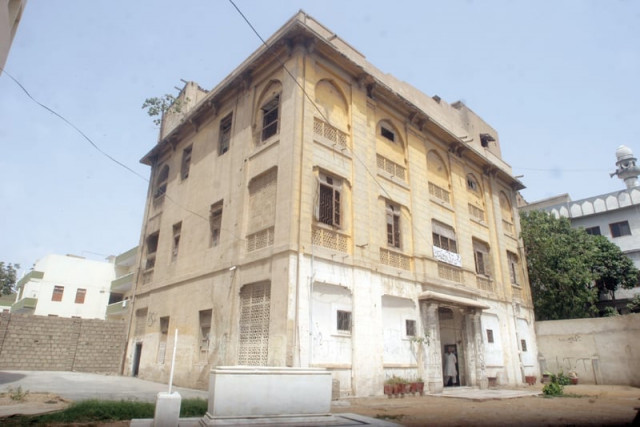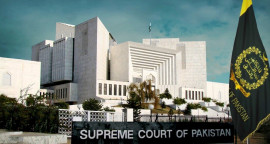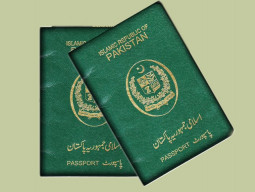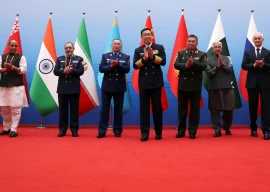
In the heart of Karachi, a ramshackle three-storey edifice, adjacent to the Federal Urdu University of Arts, Science and Technology (FUUAST) ‘Maulvi Abdul Haq’ campus, exudes a strong sense of history within its crumbling walls.
Few recognise the building as the earliest headquarters of the Anjuman-e-Taraqqi-e-Urdu Pakistan [The Council for the Promotion of Urdu], where Maulvi Abdul Haq, a pre-eminent Urdu lexicographer and researcher regarded as ‘Baba-e-Urdu’, lived on its second floor and was later buried in its compound.
The Temple of the Goddess of Knowledge
The edifice also holds a similar historical significance, if not more, for the people of neighbouring India, due to the momentous role that it played in the social, cultural, educational and political upbringing of various prominent figures for around 28 years before partition.
It was established as the Shri Sharda Mandir [The Temple of the Goddess of Knowledge] - a progressive Gujarati-medium high school that rose to national stature and was considered as one of the country’s best - whose foundation stone was laid by Mohandas Karamchand Gandhi in 1921.

More than 1,200 students were studying at the institute at the time of the partition, when the institute’s activities came to a grinding halt and the building was abandoned amidst fears of communal violence.
Alumni of the school, like octogenarian maths whiz, Labhachandra Shantilal Doshi, hold on to the memories associated with their alma mater, crediting it for providing them with confidence they needed to succeed in life.
Doshi currently resides in the suburbs of Mumbai in Vile Parle, a popular choice among the Gujarati population, including many families that migrated from Pakistan. Doshi, while talking to The Express Tribune over the phone, said that the Gujarati school was like an ‘ashram with bright airy classes covered with a myriad of creeping plants’.
He recalled that the school’s principal, Mansukhram Jobanputra, generally addressed by the students as ‘Bapuji’, was a close companion of Gandhi.
“Bapuji and the teachers were like sages, who instilled within the students a strong sense of ethics,” said Doshi, who studied at the institution for seven years - from 1940 to 1947 - with many of the country’s elite, including former Sindh Chief Minister, Sir Ghulam Hussain Hidayatullah. He recalls attending lectures delivered by the late Shakuntala Devi, a celebrated mathematician, and others who were invited by the principal and the school’s president Jamshed Nusserwanjee Mehta, Karachi’s first elected mayor.

Apart from Gandhi, who used to take keen interest in the school’s activities, said Doshi, other socio-political reformers and leaders, including Pundit Jawaharlal Nehru and Maulana Abul Kalam Azad, used to address the students and stay at the institution’s guestrooms during visits.
At the time of the partition, Gandhi had expressed his desire that the Sharda Mandir should continue its services in India, following which the institute was restructured as the Shri Shardagram, established near Mangrol in the Junagadh district of Gujarat in April, 1949, claimed the managing trustee of the Shri Shardagram Prof JG Bhuva.
Anjuman-e Taraqqi-e-Urdu Pakistan headquarters
At the other side of the border, the office and a significant portion of the valued library of the Anjuman in Delhi were ransacked in post-independence riots.
The Anjuman was founded in 1903 for the promotion of the Urdu language and its literature, during the sixteenth annual All-India Muslim Educational Conference organised in Delhi. Haq had been serving as the Anjuman’s secretary since 1912; a position that he held till his death in 1961.
Thereafter, ‘Baba-e-Urdu’ migrated to Karachi, bringing with him only limited manuscripts and books from the Anjuman’s invaluable library and instituted the Anjuman anew by registering it under the Societies Registration Act 1860 as ‘Anjuman-e-Taraqqi-e-Urdu Pakistan’.

Later in October 1948, the Karachi Municipal Corporation granted permission for the Sharda Mandir premises to serve as the headquarters for the Anjuman’s Pakistan branch, recalled Jamiluddin Aali, former secretary of the Anjuman who succeeded Baba-e-Urdu.
“Here at its vast compound, the FUUAST, being the brainchild of the Anjuman, was established initially as the Urdu College in 1949,” said Aali. “People of my age still reminisce of the summer evenings when Baba-e-Urdu was often seen with his arms draped across the balcony railings of the second-floor.”
Govt fails to preserve heritage site
Despite having possession of the building, the Anjuman has failed to maintain the historical site due to what its deputy-secretary and treasurer, Dr Javaid Manzar, termed as ‘shortage of government funds’.
Years of negligence have left the internal wooden structure, the walls and the ceiling of the building in a run-down state, compelling office-bearers to move out to an alternate location in Gulshan-e-Iqbal in the early 1990s, said Dr Manzar.
While declaring this building as a “precious heritage”, the then Karachi Metropolitan Corporation’s (KMC) technical services director-general, Altaf G Memon, in his letter on May 10, 2012, to the Sindh culture department secretary, stated that the KMC, in order to protect the building from further wear and tear, intends to take up rehabilitation and maintenance work and requires approval from the department to carry out the task, ensuring that the building is protected and maintained.
Meanwhile, The Express Tribune has learnt that the KMC had subsequently approved Rs3.7 million for its renovation, but two years on, the corporation still looks forward to a formal approval by the provincial culture department.
“After renovation and maintenance, the council wants to convert this building into a state-of-the-art Urdu Museum that would serve as a hub of knowledge for researchers, students and lovers of the language,” said Dr Manzar.
Meanwhile, mathematician Labhachandra Shantilal Doshi, owing to his immense emotional attachment with his alma mater, believed that the Pakistani government would do a great favour to present and forthcoming generations of both countries by preserving their mutual history and heritage through the building.
Published in The Express Tribune, July 1st, 2014.


















COMMENTS
Comments are moderated and generally will be posted if they are on-topic and not abusive.
For more information, please see our Comments FAQ